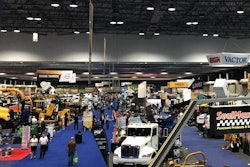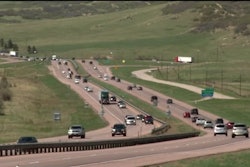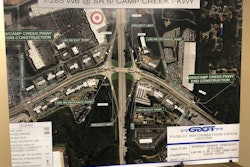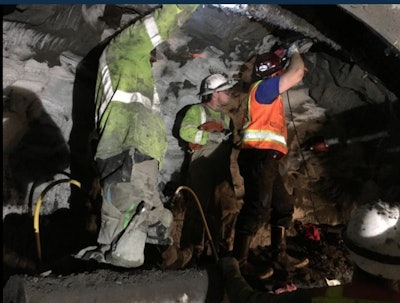 PHOTOS: SoilFreeze.
PHOTOS: SoilFreeze.SoilFreeze – a construction company specializing exclusively in ground-freezing services for the construction and environmental industries – is piquing plenty of interest this week as an exhibitor at the Public Works Expo in Kansas City, Missouri.
“SoilFreeze provides engineered structural shoring for access shafts, foundation and utility excavations and soil remediation sites. Because it works in even the most difficult soil conditions and is eco-conscious, we are seeing a surge in popularity,” says Conner Bozman, a project engineer for the firm.
SoilFreeze’s technology replaces conventional shoring such as sheet piles, caissons or grouted structures, and it offers a patented technology which can provide a frozen “plug” under large excavations, he says.
“Another big advantage of our product is that it completely eliminates the dewatering process because it creates an impermeable barrier. It doesn’t allow any groundwater to come in at all,” Bozman explains.
How it works
The company uses a calcium chloride “brine” as its refrigerant. It is an environmentally friendly salt water that is commonly used to de-ice roads and as a drying agent.
“We have a closed system, so we drive pipes or drill pipes,” he says of the process. “Our design engineers come up with what our design is, how far apart or close our pipes need to be, how deep they need to be drilled, et cetera.”
Specialized chillers that are made for their company chill the brine to a temperature of about negative 20 degrees Fahrenheit. That chilled brine is circulated through a manifold (high-density polyethylene pipes, valves and pumps) to supply the freeze pipes.
“It pulls the heat out of the ground, and from around each freeze pipe, until it completely freezes the structure in three to six weeks,” says Bozman.
The product was a show-stopper Monday for John Medlock Jr., deputy director of Maintenance and Operations for Alameda County Public Works Agency in California, and his colleague Percy Irving II, bridge and pump supervisor. They had never seen anything like this product, they say.
“It’s an innovative idea that’s probably much safer than shoring and potentially more cost-effective,” Medlock tells Equipment World. “We’re going to check it out a little bit more because we have some projects in which we might be able to utilize this technology.”
SoilFreeze, which began in 1998, has been increasingly approached by owners or contractors to employ its method of ground improvements, Bozman says.
“Our highly trained people create a culture of safety, innovation and success to solve difficult issues facing the underground construction industry,” says SoilFreeze President Larry Applegate from the company’s headquarters just outside of Seattle, Washington.
SoilFreeze has only one competitor in the United States when it comes to ground-freezing, Bozman says.
That would be Moretrench, based in Rockaway, New Jersey. Moretrench is a Hayward Baker company serving underground construction needs of the civil, environmental and industrial market sectors. Hayward Baker is one of the connected companies of Keller.
Bozman is helping to run the SoilFreeze booth at the Public Works Expo, which is a highlight of the conference attended by about 5,000 municipal and state workers in public works and transportation this week.
“We’re here at the conference because not a lot of people know the benefits of ground-freezing or even what it is. Not a lot of developers know; not a lot of engineers know,” Bozman says.
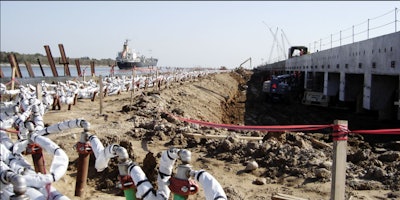
“The ones who do know or have used freeze technologies have a real advantage for constructing difficult projects. They may choose to use our frozen-soil shoring application, as opposed to mechanical shoring with expensive dewatering programs,” he says.
He says unlike dry earth, the most difficult soil conditions for building can involve groundwater.
“When you try putting an excavator on top of this kind of soil, it’s not going to work,” Bozman says. “You’re digging through soup. We create a robust frozen soil structure so they can safely excavate. And it’s cleaner. You’re not down in the muck. You’re not dealing with the water.”
In New Mexico’s desert, for example, where ambient temperatures regular hit 90 degrees or hotter and water resources are low, SoilFreeze recently froze the ground for a big manhole being dug for the Shumway Arroyo Recovery System.
Freezing the soil to stabilize shaky ground during construction
Though SoilFreeze’s product is not being marketed for its safety aspects, it can help prevent collapses given that it is designed to stabilize unstable situations, Bozman says.
By freezing the earth, SoilFreeze’s product can be used, along with other safeguards, to help prevent against excavation cave-ins and trench failures, he says.
For example, SoilFreeze built several freeze structures for a light-rail transit system in the Seattle area. It’s required there that every 600 feet, you need to build “cross passages” to connect parallel transit tunnels as a safety measure, Bozman says.
And to prevent collapse while workers are excavating down in those deep areas with high water pressure, or around tunnel-boring machines, “we freeze it,” Bozman says. “And it just creates a safe environment for those workers who are down there.”
SoilFreeze usually does big projects. The smallest was a California “mouse hole” project in which a municipal pipe was being placed beneath a railroad. The railroad company didn’t want to stop its train for the project. “But they also didn’t want the railroad to collapse into the construction project,” Bozman says.
SoilFreeze froze a horizontal arch to support the railroad embankment while a concrete box culvert was driven through it. “It essentially prevented collapse of the rail,” he says. “Basically in that project, we’re boasting the freeze was strong enough to support a train on top of it.”





